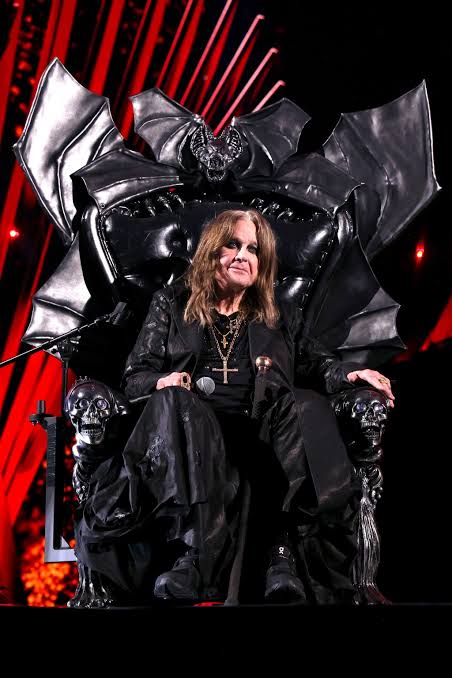**The Unveiling of Ozzy Osbourne’s Statue: A Tribute to an Icon**
It was a crisp, overcast afternoon when the small town of Birmingham, England, became the stage for a momentous occasion in music history. Fans from all over the world gathered, their faces painted with excitement and reverence. The reason? A statue was about to be unveiled in honor of one of rock and roll’s most enduring figures: Ozzy Osbourne.
Ozzy, the “Prince of Darkness,” has long been a figure synonymous with the rebellious, untamed spirit of heavy metal. From his time fronting Black Sabbath to his solo career, his influence on music and pop culture cannot be overstated. His wild antics, distinctive voice, and larger-than-life persona made him a legend not only in music but also in the hearts of fans who revered him as a symbol of resilience and defiance.
The statue, created by renowned sculptor Neil Norgrove, was set to stand proudly in the center of Birmingham, a place that birthed the icon. It was an exquisite piece of art—Ozzy, captured mid-performance, his trademark wild eyes wide with passion and his hair flowing like a storm. The sculpture portrayed him not as the mythic figure often depicted in tabloids, but as a man deeply connected to the music that made him who he was. His hands were outstretched, as if reaching out to the fans who had supported him through decades of highs and lows.
As the crowd gathered, anticipation hung thick in the air. The ceremony was a blend of awe, celebration, and reflection. The audience was made up of fans young and old, all united by the common thread of their admiration for the legendary figure. Some wore Black Sabbath shirts, others adorned themselves with Ozzy’s iconic solo album art. For many, this was a pilgrimage—a chance to honor the man whose voice had shaped their understanding of music and life.
Before the statue’s unveiling, a series of speeches took place. The first to speak was Tony Iommi, the guitarist and founding member of Black Sabbath, the band that had brought Ozzy into the limelight. Iommi was a man of few words, but when he spoke of Ozzy, the affection was evident.
“I’ve seen Ozzy grow from a young man with big dreams into the icon he is today,” Iommi said, his voice thick with emotion. “We’ve been through a lot together, and we’ve shared some incredible moments. Today, this statue is a small token to celebrate his massive contribution to music and to the world.”
Following Iommi, Sharon Osbourne, Ozzy’s wife and manager, took the stage. Her words were heartfelt, a blend of pride and admiration for the man she had stood by through thick and thin. “Ozzy is a force of nature,” Sharon said, looking out at the crowd with a smile. “He’s been through so much in his life, but his love for music and his fans has never wavered. This statue is for all of you who’ve supported him over the years, and for him—because he’s a true legend.”
As Sharon spoke, Ozzy himself stood on stage, a smile tugging at the corners of his lips. He was visibly moved, though still keeping his signature sense of humor. The crowd cheered loudly when Ozzy finally took the mic.
“I’m not really sure what to say,” Ozzy began, his voice still raspy but unmistakably his. “I never thought I’d live to see something like this, but here we are. To all the fans who’ve supported me and stuck with me, you’ve made this all possible. This statue’s not just mine—it’s ours.”
The moment everyone had been waiting for arrived. With a ceremonial gesture, the cloth that had covered the statue was pulled away, revealing Ozzy in all his glory. The crowd erupted into applause, a standing ovation that reverberated through the streets of Birmingham. Fans wept, cheered, and clapped in unison, paying tribute to the man who had been a defining voice in rock music for over five decades.
The statue, though static, seemed to capture Ozzy’s dynamic energy. It was a reminder not only of the music that had shaped the landscape of rock but also of the personal journey Ozzy had embarked on—a journey filled with highs, lows, and everything in between. From his early days in Black Sabbath, which helped to lay the foundation for heavy metal, to his solo career, which pushed musical boundaries and brought a new wave of fans into the fold, Ozzy’s contributions were undeniable.
But the ceremony was more than just a recognition of Ozzy’s music; it was also a testament to his resilience. In a career that spanned decades, Ozzy had faced personal demons, struggled with addiction, and weathered numerous controversies. Yet, through it all, he remained one of the most beloved figures in rock. His struggles, far from diminishing his legacy, only added to the mystique of his character. Fans didn’t just admire him for his music; they admired him for his tenacity, his ability to keep going despite the odds.
As the evening wore on, the ceremony turned into a celebration. A performance of “Iron Man” by a local band echoed through the streets, and fans sang along, their voices filling the air in a unified roar. Ozzy stood at the foot of his statue, taking it all in, occasionally waving and acknowledging the crowd with a nod or a gesture. For one night, the Prince of Darkness was embraced by the very city that had nurtured his talent.
The statue, now immortalized in Birmingham, was more than just a tribute to Ozzy Osbourne’s musical achievements. It was a symbol of the enduring power of rock and roll, the resilience of the human spirit, and the bond between an artist and his fans. It reminded everyone that even in the darkest of times, music could light the way, and even the most unlikely heroes could leave an indelible mark on the world.
As the sun set and the last cheers echoed into the night, one thing was clear: Ozzy Osbourne’s legacy was secure. The statue, standing tall in the heart of Birmingham, would forever be a testament to a man who had not only helped to shape rock music but had also shown the world what it meant to truly
live life on one’s own terms.









